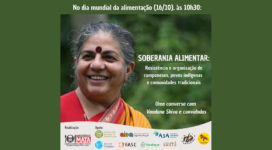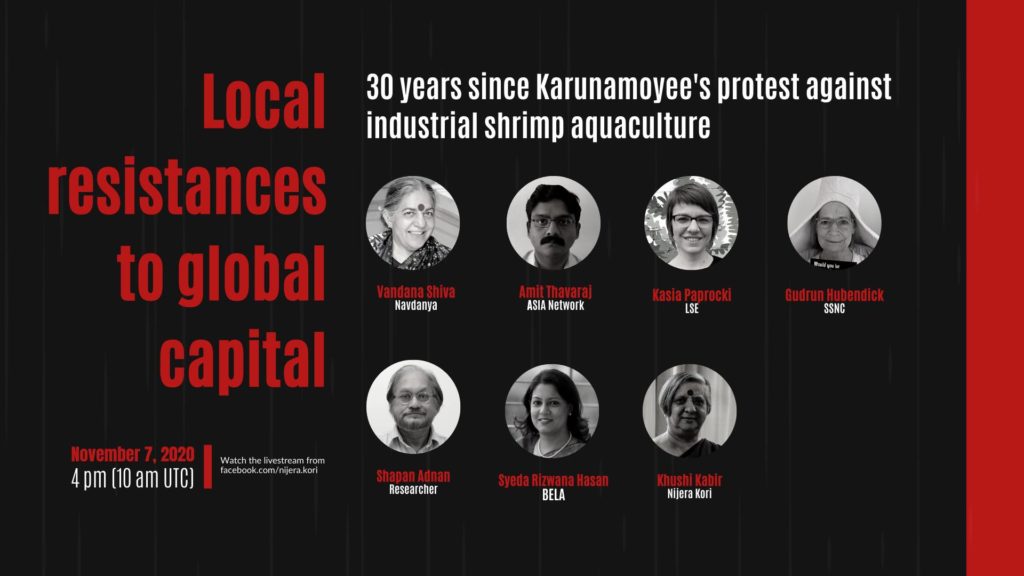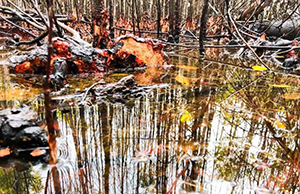SAVE THE SUNDARBANS This issue dedicated to the memory of Karunamoyee Sarder

SUNDARBANS – This is a special issue of MAP News on behalf of our
good friends in Bangladesh, especially for those brave resisters at Polder
22 who risk their lives still in defending their lands from invasive prawn
farming We urge the continued action and work, as well as continueing coordination of similar action alerts going on worldwide in memory of Karunamoyee Sarder who, on Nov. 7th, 1990, made the ultimate sacrifice in defence of her threatened community’s land and liberty. The 7th of November is upon us, and the preparation at the field level for this memorial day is going on. We issue this special and urgent appeal to our members and associates, asking that you please offer your help and support for the people of Bangladesh on this day against the continuing illegal expansion of the shrimp aquaculture industry in the Sundarbans. Nov. 7th has become an international day from this year. It was since 1990 a day commemortated by the people of Bangladesh for the bravery and ultimaste sacrifice of one of its leaders, Karunamoyee Sarder. We suggest that all of you organize your own program which fits into your work. That can be writing an article or having a minute of silence in honor of Karunamoyee and the struggle for justice and the future which her death represents. Please send a letter to Nijera Kori afterwards as to how you kept up the memory of this day in your country. This will be good feedback to the people in Bangladesh. READ MORE GLOBAL Thirty years since Karunamoyee’s protest against industrial shrimp aquaculture

GLOBAL – Karunamoyee Sarder, a landless widow from Bigardana village in Polder 22 of Khulna, Bangladesh, was murdered on November 7, 1990. Along with her fellow villagers, Karunamoyee was leading a procession against the forceful and illegal establishment of shrimp farms in the polder. Industrial shrimp aquaculture rapidly expanded in coastal Bangladesh in the mid-eighties, despite widespread evidence that it brought with it severe socioeconomic and environmental impacts, affecting the livelihoods, job security and access to land of local communities. In Bangladesh, the industry also entailed severe human rights violations, including murder and rape. Commemorating the thirtieth death anniversary of Karunamoyee, this seminar brings together activists and scholars from across the world who have first-hand experience of how the industry has affected communities in Asian and Latin American countries. They will speak of not only the history of the movement in Bangladesh, but put the events in a global perspective, exploring both past and contemporary issues. Through this programme, Bangladesh also launches the One Billion Rising 2021 campaign—the theme this year being to reclaim planet Earth from the plunder it has faced and to resist until violence against women and nature stops. READ MORE Pause before you Plant

GLOBAL – Despite the terrifying recent fires in Australia, California and Brazil there are grounds for hope that the world could finally start valuing its forests. Many governments now say they love trees. There is an increasing international effort to slow rates of forest decline and restore forests where they once stood. Seventy-six world leaders have just signed the Leaders Pledge for Nature, committing to reversing biodiversity loss by 2030, including the restoration of a significant share of degraded ecosystems. As we approach the United Nations Summit on Biodiversity, this shows the international community may be willing to chart a new direction in environmental decision-making. It follows several other international restoration initiatives, such as the Bonn Challenge to restore 350 million hectares of lost and degraded habitat over the next 10 years and calls for mass planting such as the Trillion Tree Campaign. This new political discourse on the importance of trees is welcome. It reflects a growing understanding that forests are essential for our future. READ MORE In mangrove restoration, bespoke solutions trump one-size-fits-all approach

GLOBAL – The vast tangled mangrove forests that sweep along so many tropical coasts are one of the world’s most biodiverse ecosystems. They also play crucial roles in protecting coastlines from erosion and providing communities with resources from food to firewood, and are one of our most effective carbon sinks. Yet they continue to be destroyed and degraded. In their Global Forest Resources Assessment (FRA) for 2020, the Food and Agriculture Organization of the United Nations (FAO) estimated the loss of 1.04 million hectares (2.57 million acres) over the last 30 years. However, there is some cause for some optimism. According to figures from the FRA, the rate of global mangrove loss has more than halved over three decades, from 46,700 ha (115,400 acres) of loss per year between 1990 and 2000, to 21,200 ha (52,400 acres) per year between 2010 and 2020. However, not all regions have experienced a reduction in mangrove deforestation. The FRA found that in Asia, there has been a huge increase in mangrove loss: from 1,030 ha (2,550 acres) per year to 38,200 ha (94,400 acres) over the same 30-year period. READ MORE AFRICA Mangrove forests act as sinks for plastic waste

ARABIAN GULF – The Red Sea and Arabian Gulf surface waters hold smaller volumes of plastic litter than what originally entered them. In a new study, international researchers, including from from Saudi Arabia, have found the reason for this discrepancy: mangrove forests have been sequestering substantial loads of plastic since its mass production began in the 1950s. “Conserving mangrove forests is key to avoiding the resuspension of buried plastic into the water column where they could affect marine organisms,” says the study’s lead author, Cecilia Martin, a marine scientist from King Abdullah University of Science and Technology, Saudi Arabia. Mangrove plant aerial roots and branches trap plastic items brought in by ocean currents, where they fragment into less buoyant, smaller particles. Microorganisms colonising the particles make them heavier, rapidly sinking them, where they eventually deposit in the sediment. The scientists had analysed plastic pieces extracted from dated mangrove sediments and found small fragments and films that probably came from bottles, food wraps and ropes. They also found that plastic concentration decreased from the surface to the deeper layers of the sediments. They conclude that plastic burial rates in marine sediment have risen exponentially since the 1950s, at a rate of 8.5 per cent each year, in line with the rise in global plastic production. The researchers predict burial rates will rise to 7 to 20 times higher than the present rates by 2050. READ MORE AMERICAS Education and Monitoring Programs with Cayman Islands Mangrove Rangers

CAYMAN ISLANDS – The Cayman Islands Mangrove Rangers swung into full action this fall with a variety of programs. In addition to a video series for teachers entitled ‘Creature Features’ focusing on the inhabitants and dependents of Grand Cayman’s threatened Central Mangrove ecosystem, the rangers implemented several projects. Central to these was the problem of illegal cement dumping which has been a perennial problem in Grand Cayman. Caught in the act, National Concrete cleaned up the dump and is being prosecuted under the Litter Law. Following this violation, the rangers have begun a survey of similar mangrove concrete dumps around the island and will post details of these online. Education programs also included a mangrove field trip for 60 Year 2 school kids from Cayman International School to mangroves close by the school. The field visit was followed by science class presentations to Year 10 and 11 students by Mangrove Action Project’s education director Martin Keeley. Also in October, a ranger-led ecotour of the Central Mangroves included members of the student group ‘Protect Our Future’, teachers and local media. Similar school and public education programs are planned for the rest of the year. Watch episodes of ‘Creature Features’ here. The female guardians of Venezuela’s Imataca Forest Reserve

VENEZUELA – It is around five in the morning, and the Imataca Forest Reserve is stirring with the voices of Kariña women. They advance towards the middle of the jungle, bound for the Botanamo river to gather the day’s water. Then, these indigenous women will prepare “casabe”, a circular tortilla made from cassava flour, to accompany what other members of the tribe have brought in from the hunt. After breakfast they turn to their main task of the day: managing and conserving the forest. “I have never seen my indigenous sisters so motivated, so encouraged by their work… Even with all the problems that our country is going through, these women have the initiative to better their own community,” says Cecilia Rivas, the group’s “captain”. “Captain” signifies the community’s elected leader. “The Kariña group was always dominated by men. We had neither voice nor vote before,” she explains. Cecilia’s election in 2013 marked the beginning of a transformation. READ MORE ASIA Neykurendhoo Mangrove An overview

MALDIVES – Situated in the Northern most administrative division of Maldives, Neykurendhoo has the largest known mangrove in an inhabited island of the country. The majority of the islanders depend on tourism and fishery as their main source of income, however the islanders living within the island depend on agriculture for their daily needs as well as to generate income though the sale of their produce to the capital Male’ as well as nearby islands. The main crops produced by farmers in Neykurendhoo include bananas, coconuts, chilies and breadfruits. Groundwater is being used for agriculture as well as household purposes. The island freshwater lens is well maintained probably due to the mangrove/wetland. Residents of Neykurendhoo began to discover the status of the prized wetlands when they ventured into the area to collect mangroves for Ramadan (around April) in 2020. The wetland of Neykurendhoo, is among the largest in the country. The most prominent mangrove in the area is the small-leafed orange mangrove, locally called kan’doo (Bruguiera cylindrical). Residents of Neykurendhoo grew up by sourcing food from these trees. The area has been plagued by an unknown phenomenon since March, leaving the trees yellowed and dried up. READ MORE India’s CUSAT assists Maldives EPA probe cause of mangrove die-off

MALDIVES – Environmental Protection Agency (EPA) is being assisted by the Cochin University of Science and Technology (CUSAT) of India to determine the cause of the die-off of mangroves in several Maldivian islands. The large-scale die-off of mangroves in Maldives came to attention back in March. The first cases were reported from H. A. Kelaa and H. Dh. Neykurendhoo. The phenomenon has since been reported from 11 islands, including Sh. Feydhoo, H. A. Uligan, and G. Dh. Hoadedhoo. Authorities conducted field surveys to determine the cause of the phenomenon in Kelaa and Neykurendhoo, but have yet to publish the findings. Maldives is home to 15 mangrove species, including the rare bruguiera hainesii species, one of the two critically endangered mangrove species listed in the IUCN Red List of Threatened Species. The rare mangrove species was discovered from Kelaa in March. READ MORE Ban GCM for claiming ownership of our coal

BANGLADESH – A controversial energy company, forced to wind down most of its operations and exposure in Bangladesh following a popular opposition from the local population, is now claiming Phulbari’s coal deposits as their resources. On October 15, the company, GCM Resources PLC, announced that it signed a framework agreement with China Nonferrous Metal Industry’s Foreign Engineering and Construction Co., Ltd (otherwise known as NFC) and Power Construction Corporation of China, Ltd (PowerChina) in relation to its world-class 572 million tonnes (JORC 2004 compliant) of high-grade coal resources at the Phulbari Coal and Power Project in northwest Bangladesh. GCM in the past used to say it had “identified a high-quality coal resource of 572 million tonnes at the Phulbari Coal and Power Project in Bangladesh”. The JORC Code provides minimum standards for public reporting to ensure that investors have all the information they would reasonably require for forming a reliable opinion on the results and estimates being reported. As GCM Resources PLC is an AIM-quoted mining and energy company, these announcements are regulatory requirements. AIM is the Alternative Investment Market of London Stock Exchange (LSE) where listings of companies give them opportunities to raise funds. In the two weeks since the announcement, there has been increased trading activities involving GCM shares and at least thrice they had to announce Price Monitoring Extension to extend the auction call period. Auction call extensions give electronic order book users a further opportunity to review the prices and sizes of orders before the execution occurs. READ MORE AUDIO FEATURE Conservation Heroes
Welcome to Conservation Heroes, the heroes of this show are the dolphins, bats, otters, mangroves, newts and many others who are protecting our environment right now. This show will look at different laws, guidelines, or policies and will also offer you some top tips to help you protect our planet and even become a conservation hero yourself. Episodes contain interviews from scientists, academics, lawyers, environmental activists and more. The guest for this episode is Dominic Wodehouse, from Mangrove Action Project, in joining us from Manila to talk to us all about Mangroves
LISTEN NOW VIDEO FEATURE Commemorating the thirtieth death anniversary of Karunamoyee and the movement against commercial shrimp aquaculture in Bangladesh, this seminar brings together distinguished activists and scholars from across the world who have first-hand experience of how the industry has affected communities in Asian and Latin American countries. They will speak of not only the history of the movement in Bangladesh, but put the events in a global perspective, exploring both past and contemporary issues. Join us on on November 7, 10 am UTC, here The event is organised by Nijera Kori, One Billion Rising, Asia Solidarity against Industrial Aquaculture (ASIA), Navdanya, and the London School of Economics Social Life of Climate Change initiative. Thanks a lot
—
Khushi Kabir
Coordinator
Nijera Kori Like this newsletter?
Pease consider donating to MAP to keep it going.
Giving could never be easier  | ACTION ALERTSOur Paradise and Sovereignty under Siege – Protect Grenada from Destructive Development! SIGN THE PETITIONStop the destruction of Can Gio Mangrove Biosphere Reserve
SIGN PETITION (Scroll down in linked page for English version)Please SIGN: keep plantations out of orangutan habitat!
TAKE ACTION
Unilever: stop destroying mangroves for convenience food! SIGN OUR PETITION
Stop plundering the oceans for industrial aquaculture! SIGN THE PETITION

Like this newsletter? Pease consider donating to MAP to keep it going. Giving could never be easier
CBEMR Training in Tanzania: Ground-breaking training breathes life into mangrove ecosystem restoration – The Mangrove Alliance Please see our newest video: ” Restoring The Natural Mangrove Forest” – https://youtu.be/Vh7CoPBLQa8 Mangrove Restoration Map VIEW MAP HERE 
Restoring The Natural Mangrove Forest
Watch movie 
Community Based Ecological Mangrove Restoration in Rufiji Delta VIEW VIDEO Video: Mangroves for the Future – A look bacK. As the latest phase of Mangroves for the Future (MFF) draws to a close, this video highlights some of the project’s most successful initiatives – from local women supporting national park management in Viet Nam to an island in the Maldives that has become a model for waste management, and everything in between. View Here WANT TO GET INVOLVED?
Follow and Join MAP!    
Like this newsletter? Pease consider donating to MAP to keep it going. Giving could never be easier 

Singing for the Sundarbans WATCH HERE Entrevista con Monica Quarto del Mangrove Action Project (Spanish language) Oye Aqui
VOLUNTEER OPPORTUNITY 
MANGROVE ISSUES Want to learn more about mangroves?
Our short presentation will give you a better understanding of the issues we are working to solve. WATCH PRESENTATION What is CBEMR? Download MAP’s 2 page CBEMR Information Sheet containing links to all MAP’s CBEMR resources – CLICK HERE What is EPIC? – The Ecosystems Protecting Infrastructure and Communities (EPIC) project: the role of ecosystems as protective barriers against climate induced hazards MANGROVES APP AVAILABLE
A pictorial field guide for easy identification of various mangrove species and learning about the mangroves ecosystem. CLICK HERE View MAP’s uploaded Videos at MAPmangrover’sChannel
Question Your Shrimp Consumer/Markets Campaign!
WATCH VIDEO Mangrove Restoration in Asia – Watch Short Video The Value of Mangrove Forests View Video CBEMR Experience Exchange MAP 2017 English Subtitles
VIEW THE VIDEO Mangroves: Guidebook to Malaysia – Click Here
Mangrove rehabilitation in Asia – Local Action and cross-border Transfer of Knowledge for the Conservation of Climate, Forests and Biodiversity VIEW VIDEOS HERE SHARE MAP’S VISION
CLICK HERE to watch short introductory video. Together we can work “at the roots of the sea”. Our short documentary, Reducing the Risk of Disaster through Nature-Based Solutions : Mangroves

INTERVIEW – Yale Climate Connection interview with MAP’s Alfredo Quarto LISTEN Exclusive Interview with Alfredo Quarto, Co-Founder and Executive Director of Mangrove Action Project – See more
Marvellous Mangroves Curriculum The Marvellous Mangroves Education Forum is an online hub for those utilizing the Marvellous Mangroves (MM) Curriculum. It gives students, teachers and anyone interested in mangroves, the opportunity to learn and share ideas themed around the curriculum, to connect and communicate with others around the globe whilst exploring mangroves from your computer or on the go. VISIT 
The award-winning Marvellous Mangroves (MM) curriculum educates children on the importance of mangroves and their ecological functions, teaching them about modern challenges and mechanisms for sustainability. VIEW VIDEO Marvellous Mangroves Curriculum in Bangladesh – WATCH VIDEO
MARVELLOUS MANGROVES IN BRAZIL
En Portuges 
Marvellous Mangroves – A Curriculum-Based Teachers Guide. FOR MORE ON MAPs AWARD WINNING CHINA MANGROVE CURRICULUM VISIT

VIMEO SHOW
VISIT OUR “MM” WEBPAGE Check out our presentation for more details on Marvellous Mangroves Read this 10 page history of the development of MAP’s educational curriculum VIEW DOCUMENT
Article in Canada’s Green Teacher Magazine – Read More
Like this newsletter? Pease consider donating to MAP to keep it going. Giving could never be easier 
Green Planet Fundraising Assists MAP – LEARN MORE
Volunteer Opportunities with Mangrove Action Project CLICK HERE
“Question Your Shrimp” Campaign Question Your Shrimp- Don’t Buy or Sell Imported Tropical Shrimp! Sign the Petition Learn more about the affects of the shrimp industry on mangroves by visiting our blog
Editor’s Note: Mangrove Action Project’s Executive Director, Alfredo Quarto was interviewed about shrimp by Green Acre Radio’s Martha Baskin
LISTEN TO INTERVIEW Sign the Consumer’s Pledge to avoid imported shrimp
Note to Our Readers: We strive to keep active links in our newsletter. However, due to circumstances beyond our control, occasionally links to stories may become broken. If you find a link to a story is not functioning, please cut and paste the headline into your browser search bar. In most cases you should be able to locate the original story.
Not yet a MAP News subscriber?
Click here to subscribe.
|


























